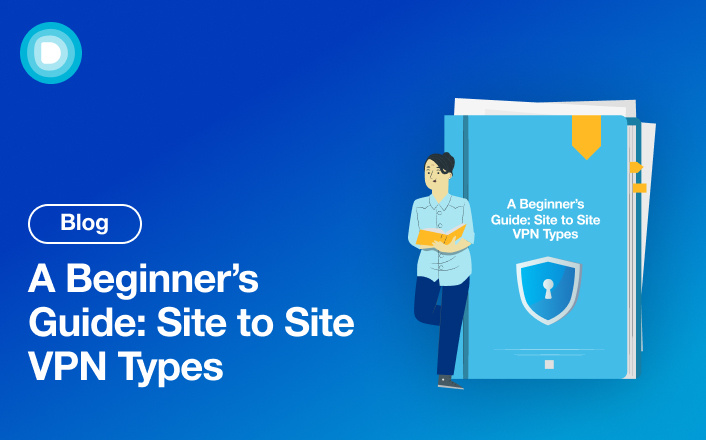- Product
-
Solution
-
By Industry
Cybersecurity solutions tailored to your industry’s needs.
-
- Resources
-
Books
Our ultimate guides and playbooks
Solution Briefs
Overview of PureDome’s functionality
-
Quizzes
Assess your cybersecurity readiness
Case Studies
PureDome customer success stories
Newsletter
Subscribe to the PureDome newsletter
-
- About Us
- Partner
- Pricing
- Download
A Beginner’s Guide: Site to Site VPN Types
-
Aiman Ikram
-
20 Jun 2024
- 2 min read


Site-to-Site VPNs play a crucial role in securely linking multiple remote networks over the internet or private networks. These VPNs enable seamless communication and data exchange between geographically dispersed offices, ensuring confidentiality and integrity of transmitted information.
Explore the fundamentals of different types of Site-to-Site VPNs, their significance in modern network infrastructure, and how they safeguard data across distributed organizational networks.
Different Types of Site to Site VPN
IPsec VPNs (Internet Protocol Security VPNs):
IPsec VPNs are one of the most common types of Site-to-Site VPNs. They operate at the network layer (Layer 3) of the OSI model and use IPsec protocols to secure data transmitted between networks over the Internet or other untrusted networks. IPsec VPNs authenticate and encrypt each IP packet of a communication session, ensuring data confidentiality, integrity, and authenticity. They are widely used due to their robust security features but may require more configuration compared to other VPN types.
MPLS VPNs (Multiprotocol Label Switching VPNs):
MPLS VPNs operate at the data link layer (Layer 2) or network layer (Layer 3) and are typically provided by service providers. MPLS uses labels to forward packets along predetermined paths through the provider's network, ensuring reliable and predictable performance with low latency. MPLS VPNs are suitable for organizations requiring high-performance, scalable, and secure connectivity between multiple locations. They offer strong Quality of Service (QoS) capabilities, making them ideal for voice and video applications.
SSL/TLS VPNs (Secure Socket Layer/Transport Layer Security VPNs):
SSL/TLS VPNs operate at the application layer (Layer 7) of the OSI model and provide secure remote access to network resources through a web browser interface. They leverage SSL or TLS protocols to establish encrypted tunnels between a user's device and the corporate network, allowing employees to securely access applications and data from remote locations or mobile devices. SSL/TLS VPNs are user-friendly, supporting a wide range of devices and offering granular access controls.
GRE Tunnels (Generic Routing Encapsulation Tunnels):
GRE tunnels are a type of tunneling protocol that encapsulates a wide variety of network layer protocols inside virtual point-to-point links. GRE tunnels establish direct, secure connections between remote networks across an untrusted network, such as the Internet. They are often used to create Site-to-Site VPNs between different locations or branch offices, facilitating seamless integration of disparate networks and enabling multicast routing.

Implementing Site-to-Site VPNs
Implementing Site-to-Site VPNs involves assessing network needs to determine which sites require connection. You then select a suitable VPN technology, such as IPsec or MPLS. Configure VPN devices at each site and set up encryption and authentication methods. Establish routing protocols to facilitate traffic between interconnected sites. Test connectivity thoroughly to ensure reliability. Monitor performance continuously and maintain security through regular updates and staff training, ensuring seamless communication across the organization.
Future Trends in Site-to-Site VPN Technology
Future trends in Site-to-Site VPN technology are evolving to meet the growing demands of modern networking environments:
Integration with SD-WAN: Site-to-Site VPNs are increasingly integrating with Software-Defined Wide Area Network (SD-WAN) solutions. This integration allows for dynamic traffic management, improved application performance across distributed networks, and centralized policy management. SD-WAN enhances the flexibility and efficiency of Site-to-Site VPNs by optimizing traffic routing based on real-time conditions.
Cloud Integration: There is a growing trend towards integrating Site-to-Site VPNs with cloud services. This includes establishing secure connections between on-premises networks and cloud platforms (such as AWS, Azure, or Google Cloud), ensuring secure access to cloud resources and facilitating hybrid cloud deployments. Cloud-integrated VPNs provide scalability, flexibility, and cost-efficiency for organizations adopting cloud-first strategies.
Enhanced Security Capabilities: Future Site-to-Site VPN technologies are expected to incorporate advanced security features to address evolving cyber threats. This includes improvements in encryption standards, stronger authentication mechanisms, and enhanced intrusion detection and prevention systems (IDPS). Additionally, technologies like Zero Trust Network Access (ZTNA) are being integrated to enforce strict access controls and verify every device attempting to connect to the VPN.
How PureDome Helps
PureDome helps businesses by ensuring secure and reliable communication between multiple locations through its Site-to-Site VPN feature. It establishes encrypted tunnels over the internet or private networks, allowing seamless data exchange while safeguarding against unauthorized access. This ensures that sensitive information remains protected, enhances operational efficiency, and supports collaboration across distributed offices or branches.
Frequently Asked Questions
What are Site-to-Site VPNs?
Site-to-Site VPNs securely connect multiple remote networks over the internet or private networks, ensuring data confidentiality and integrity.
Why use IPsec VPNs?
IPsec VPNs offer robust security through encryption and authentication, making them ideal for protecting data transmitted between networks.
How do MPLS VPNs differ?
MPLS VPNs prioritize performance with predictable low latency, using label-switched paths to optimize traffic flow across provider networks.